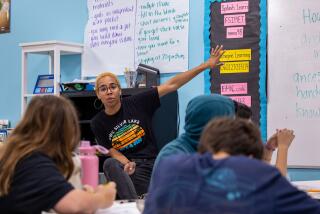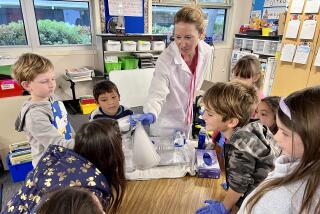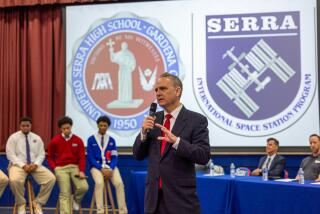NASA lessons get down to Earth
Thirty-five Southern California science-loving teachers had stratospheric hopes on Saturday: to follow in the footsteps of Barbara Morgan, the first teacher to complete a mission in space, by learning how to apply in their classrooms what she did during her two weeks in orbit.
But instead of traveling to space, the teachers, from grades kindergarten through 12, gathered at the NASA Dryden Education Center in Palmdale, coming from as far as San Diego.
During a free six-hour seminar in a packed room, they learned about the mechanics of the space shuttle, how the astronauts prepare meals in space and how teachers can tap into NASAâs resources. They even got some hands-on instruction in making a grappling device with foam cups and string, similar to the one Morgan operated on the International Space Station.
âWe want to inspire our students to be the next Barbara Morgan,â said Cheri Pratt, 55, who teaches special education for grades three through five at Canoga Park Elementary School.
âBy doing these practical experiments and activities, we can inspire students early on to think about growing up to be a scientist,â she said.
Although the 10 NASA centers throughout the nation frequently hold educational seminars, the most recent shuttle mission had a unique connection to education because of Morgan.
The Fresno elementary school teacher was selected in 1985 as the alternate to Christa McAuliffe, the teacher picked to go to space on the ill-fated 1986 Challenger mission, in which she and six astronauts were killed.
More than 21 years later, Morgan carried out McAuliffeâs mission, returning to Earth last week and renewing enthusiasm for NASAâs teacher programs, said Michelle Davis-Judd, who is in charge of NASA Drydenâs educational programs for Southern California and Arizona.
Itâs a feeling echoed by two workshop attendees: Kelly Chamberlin-Fountain, a seventh-grade language arts teacher at Lancasterâs Park View Middle School, and her sister, Shannon Chamberlin, an astronomy teacher at Hilltop Middle School in San Diego. Both said they would display posters showing the shuttle and Morgan and McAuliffe in their home rooms, hoping to motivate students to care about space.
âI was heartbroken . . . when Challenger exploded,â Chamberlin-Fountain said. âI was in seventh grade, and to be a kid and see a teacher killed in space was traumatizing, but Barbara has helped heal that wound for many.â
One of the main purposes of the workshop was to give teachers lesson plans that apply scientific theories to practical activities, for example doing a backward crab walk to show the coordination needed to walk in space or increasing spatial awareness by standing on one foot and tossing a ball.
âDonât be shy,â said Beth White, the NASA aerospace education specialist leading the seminar, as she solicited volunteers to practice what they would be preaching in the classroom.
A few teachers braved the laughter and, amid supportive shouts of colleagues, balanced on one foot. Only one was courageous enough to do a crab walk.
A teacher seated in the front row, Kim Disbrow, asked the question that White described as inevitable in the seminars.
âSo, how do the astronauts go to the bathroom?â asked Disbrow, who teaches first grade at Desert View Elementary School in Lancaster.
White smiled. âEssentially, they use a diaper.â Amid laughs, one teacher retorted with âDo they track boyfriends?â a reference to former astronaut Lisa Nowak, who was said to have worn such a diaper on a 950-mile drive from Texas to Florida to confront a romantic rival.
The seminar turned serious when teachers expressed concerns about trying to make science more alluring to students who need to boost their grades and test scores.
âScience is hands-on. You learn by doing, and kids love that,â said Disbrow, adding that she has pinned her hopes on including space education in her schoolâs English as a second language curriculum. âWith a language, you can have a communication barrier, but science goes beyond that.â
NASA offers a variety of free programs and routine workshops that are listed at www.nasa.gov/education, and area educators can also call (661) 276-7570 for information.
On Saturday in Palmdale, many teachers said the workshop helped them learn the basics about space and was something they could take home with them and grow from.
The workshop culminated with teachers using household items like soda bottles to design a âgrowth chamberâ for plants on the shuttle, just as Morgan tended to cinnamon basil plants and seeds while in flight.
Some of the teachers said they were on a NASA waiting list for some of the 10 million seeds that flew in space with Morgan. White said the seeds will find a home in the growth chambers the teachers designed Saturday for their classrooms.
--
francisco.varaorta @latimes.com
More to Read
Sign up for Essential California
The most important California stories and recommendations in your inbox every morning.
You may occasionally receive promotional content from the Los Angeles Times.










